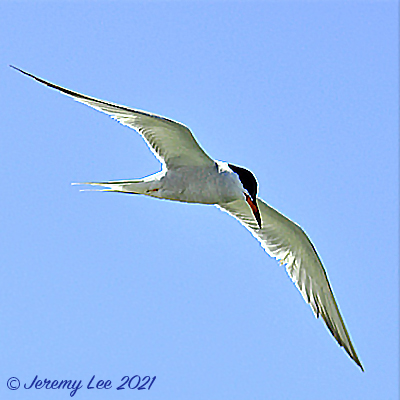
 |
|
Scientific Classifications explained » Amphibians » Ants » Aphids » Bees » Beetles » Birds » Bugs » Butterflies » Caterpillars » Damselflies » Dragonflies » Earwigs » Flies » Frog/Leafhoppers » Fungi » Galls » Grasshoppers » Harvestmen » Hoverflies » Lacewings » Ladybirds » Leaf Mines » Lichens » Mammals » Millipedes » Mosses » Moths » Sawflies » Slugs » Snails » Spiders » Trees & Shrubs » Wasps » Wild Flowers » Woodlice » Postboxes |
UK Nature > Birds > Sterna hirundo

Scientific Name: Sterna hirundo Common Name: Common Tern Sterna hirundo, more commonly known as the Common Tern, is slightly larger and longer-legged than the similar Arctic Tern (Sterna paradisaea), with shorter wings and a black-tipped red beak. Most terns seen on inland waters will be this species. These delightful silvery-grey and white birds have long tails which have earned them the nickname 'sea-swallow'. They have a buoyant, graceful flight and frequently hover over water before plunging down for a fish. They are often noisy in company and breed in colonies along coasts with shingle beaches and rocky islands, on rivers with shingle bars, and at inland gravel pits and reservoirs, feeding along rivers and over freshwater. Migrating birds can be seen offshore in autumn. They are in residence in the UK throughout the summer, arriving in April and leaving in August and September. They are most obvious when feeding their young as they will fly some distance for food, returning to the nest site with a fish. |
|

https://www.uknature.co.uk is a website dedicated to showing the immense diversity of UK nature and wildlife. Our vast range of habitats, from lowland arable to snow covered mountains, from storm-ravaged coastlines to peaceful inland freshwater lakes and rivers, from dry, sandy heaths to deciduous and coniferous forests, all these habitats contribute to the abundance of UK nature. We have wild birds in huge numbers either residing or visiting our shores (597 recorded species as at July 2013) and we must also not forget the humble back garden with its grass lawns, flower beds filled with nectar rich flowers, shrubs and trees, all designed to attract huge numbers of insects such as bees, moths, butterflies and hoverflies; and finally the small ponds which provide safe havens for frogs, toads, newts and even slow worms and grass snakes. www.uknature.co.uk is the showcase for my personal passion, photographing uknature in all its glory. I sincerely hope you all enjoy the fruits of my labours. This site and all images contained therein is © Jeremy Lee 2004 - 2025. All Rights Reserved. Site design by Jeremy Lee. Site development & IT Support by Stuart Lee. |